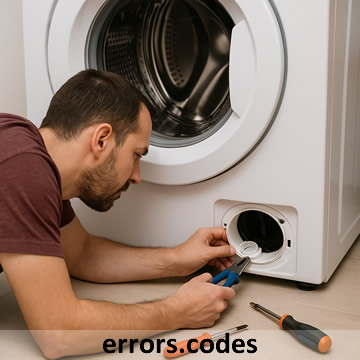My Washing Machine Won’t Drain and the Filter Is Clean [Possible Causes and How to Fix It]
Table of Contents
Why won’t my washing machine drain if the filter is clean?
When your washing machine won’t drain even though the filter is clean, it can be frustrating — and it’s not always related to the filter. There are other components and issues that may be preventing the water from draining. Here are the possible reasons.
- Blocked or faulty drain pump: Even with a clean filter, the pump might contain small objects, lint, or it could be burnt out, preventing it from working properly.
- Kinked or clogged drain hose: If the hose is incorrectly positioned, pinched, or clogged, the water won’t be able to drain properly.
- Pressure switch issues: If this water level sensor isn’t detecting the level correctly, it may prevent the drain cycle from starting.
- Electrical faults or control board issues: A malfunctioning electronic module might not send the command to activate the drain pump.
- Cycle programming error: Sometimes, choosing an incorrectly configured program or manually interrupting it can leave water in the drum.

Effective solutions if your washing machine won’t drain despite a clean filter
Here are a series of steps you can take to try and resolve the issue yourself. Follow these recommendations calmly and carefully to identify the root cause of the fault.
- Check the drain pump condition: Locate the pump, usually next to the filter. Make sure there are no objects stuck in the impeller. If the pump makes no noise or vibrations during the drain cycle, it might be burnt out and require replacement.
- Inspect the drain hose: Disconnect it and ensure it’s not blocked or bent. You can blow air through it or use water pressure to make sure it’s clear.
- Test the pressure switch: Find the pressure switch and its hose. Carefully disconnect the hose and blow through it to check for blockages. If it’s dirty or damaged, it could be giving false water level readings.
- Perform a full reset: Unplug the machine from power for a few minutes. Then plug it back in and select a drain or spin cycle to see if it responds.
- Listen for the pump noise: During the draining attempt, get close to the washer. If you don’t hear any buzzing or vibration, the pump may not be receiving power or could be faulty.
- Check the electronic control board: If you’re comfortable using tools and have basic knowledge, open the control panel and inspect for burnt components or loose connections.
- Try another program: Start a short cycle or the drain cycle directly to check if the issue continues. Sometimes the selected program has a temporary glitch.
- Call a technician if nothing works: If none of these checks solve the issue, the best option is to contact a qualified service technician. The fault might be within the electronics or a component requiring professional diagnosis.
If you’ve made it this far, chances are you’ve already cleaned the filter and your washing machine still won’t drain. Identifying the exact cause isn’t always easy. However, by following these steps you can rule out several common issues.
Always prioritize your safety by unplugging the appliance before handling it, and don’t hesitate to call a technician if the issue persists. With proper maintenance, your washing machine should return to normal operation without further problems.
